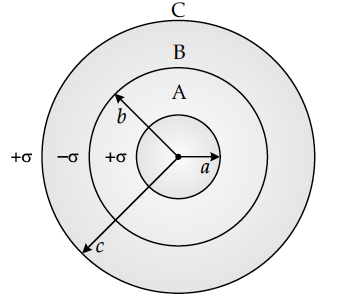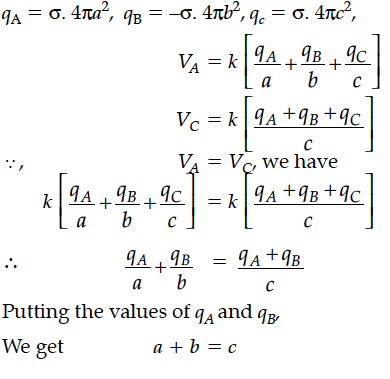Three concentric metallic shells A, B and C of radii a, b and c (a < b < c) have surface charge densities +σ, –σ and +σ respectively as shown in the figure.

If shells A and C are at the same potential, then obtain the relation between the radii a, b and c.

If shells A and C are at the same potential, then obtain the relation between the radii a, b and c.

Four point charges Q, q, Q and q are placed at the corners of a square of side ‘a’ as shown in the figure.
Two point charges q and –2q are kept d distance apart. Find the location of the point relative to charge q at which potential due to this system of charges is zero.
A charge ‘q’ is moved from a point A above a dipole of dipole moment ‘p’ to a point B below the dipole in equatorial plane without acceleration. Find the work done in the process.
What is the amount of work done in moving a point charge around a circular arc of radius r at the center where another point charge is located ?
Find the P.E. associated with a charge q if it were present at the point P with respect to the ‘setup’ of two charged spheres, arranged as shown. Here O is the mid-point of the line O1O2.
(i) Derive the expression for the electric potential due to an electric dipole at a point on its axial line.
(ii) Depict the equipotential surface due to electric dipole.
Figure shows the field lines due to a positive charge. Is the work done by the field in moving a small positive charge from Q to P, positive or negative? Give reason.
Write two properties of equipotential surfaces. Depict equipotential surfaces due to an isolated point charge. Why do the equipotential surfaces get closer as the distance between the equipotential surfaces and the source charge decreases ?
A network of resistors is connected to a 16 V battery with internal resistance of 1 Ω, as shown in the following figure. Compute the equivalent resistance of the network.
A battery of emf 10 V and internal resistance 3 ohm is connected to a resistor. If the current in the circuit is 0.5 A, find :
(i) the resistance of the resistor;
(ii) the terminal voltage of the battery.
The figure shows a plot of terminal voltage ‘V’ versus the current ‘i’ of a given cell. Calculate from the graph
(i) emf of the cell and (ii) internal resistance of the cell.
Five charges, q each are placed at the corners of a regular pentagon of side a.
(i) What will be the electric field at O if the charge from one of the corners (say A) is removed ?
(ii) What will be the electric field at O if the charge q at A is replaced by - q ?
Draw a plot showing the variation of (i) electric field (E) and (ii) electric potential (V) with distance r due to a point charge Q.
Find the expression for electric field intensity in an axial position due to electric dipole.
